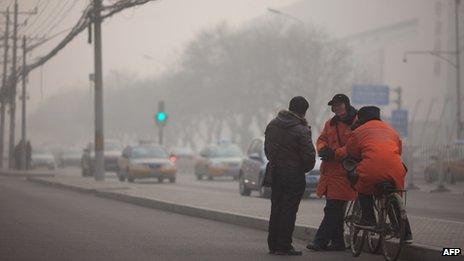Beijing air pollution soars to hazard level
- Published

The air smells of coal dust and car fumes
Air pollution in the Chinese capital Beijing has reached levels judged as hazardous to human health.
Readings from both official and unofficial monitoring stations suggested that Saturday's pollution has soared past danger levels outlined by the World Health Organization (WHO).
The air tastes of coal dust and car fumes, two of the main sources of pollution, says a BBC correspondent.
Economic growth has left air quality in many cities notoriously poor.
A heavy smog has smothered Beijing for many days, says the BBC's Damian Grammaticas, in the capital.
By Saturday afternoon it was so thick you could see just a few hundred metres in the city centre, our correspondent says, with tower blocks vanishing into the greyness.
Hazy view
Even indoors the air looked hazy, he says.

Some people are wearing masks
WHO guidelines say average concentrations of the tiniest pollution particles - called PM2.5 - should be no more than 25 microgrammes per cubic metre.
Air is unhealthy above 100 microgrammes. At 300, all children and elderly people should remain indoors.
Official Beijing city readings on Saturday suggested pollution levels over 400. An unofficial reading from a monitor at the US embassy recorded 800.
Once inhaled, the tiny particles can cause respiratory infections, as well as increased mortality from lung cancer and heart disease.
Last year Chinese authorities warned the US embassy not to publish its data. But the embassy said the measurements were for the benefit of embassy personnel and were not citywide.
- Published18 October 2012
- Published21 January 2012
- Published16 May 2012
- Published5 June 2012